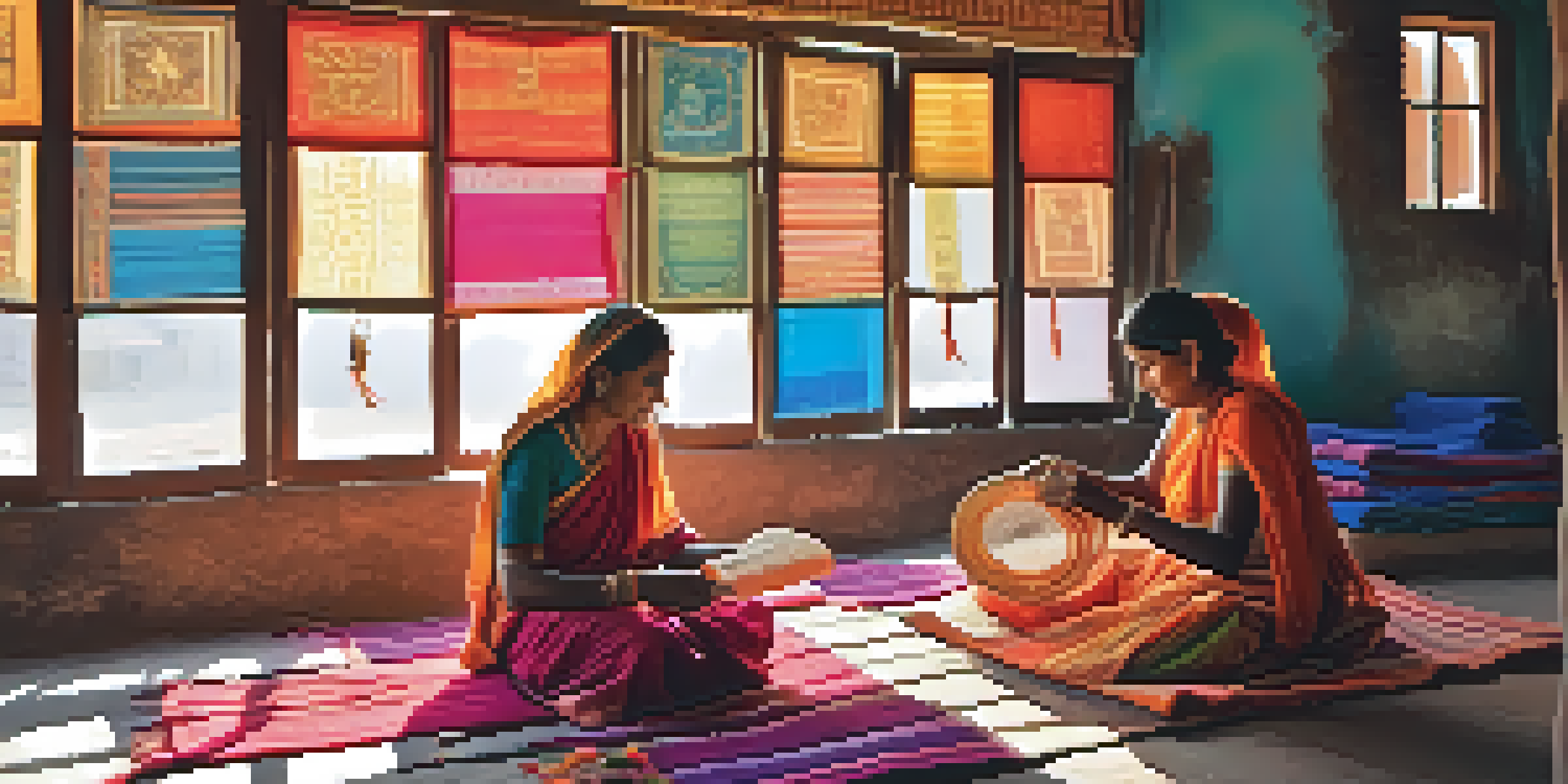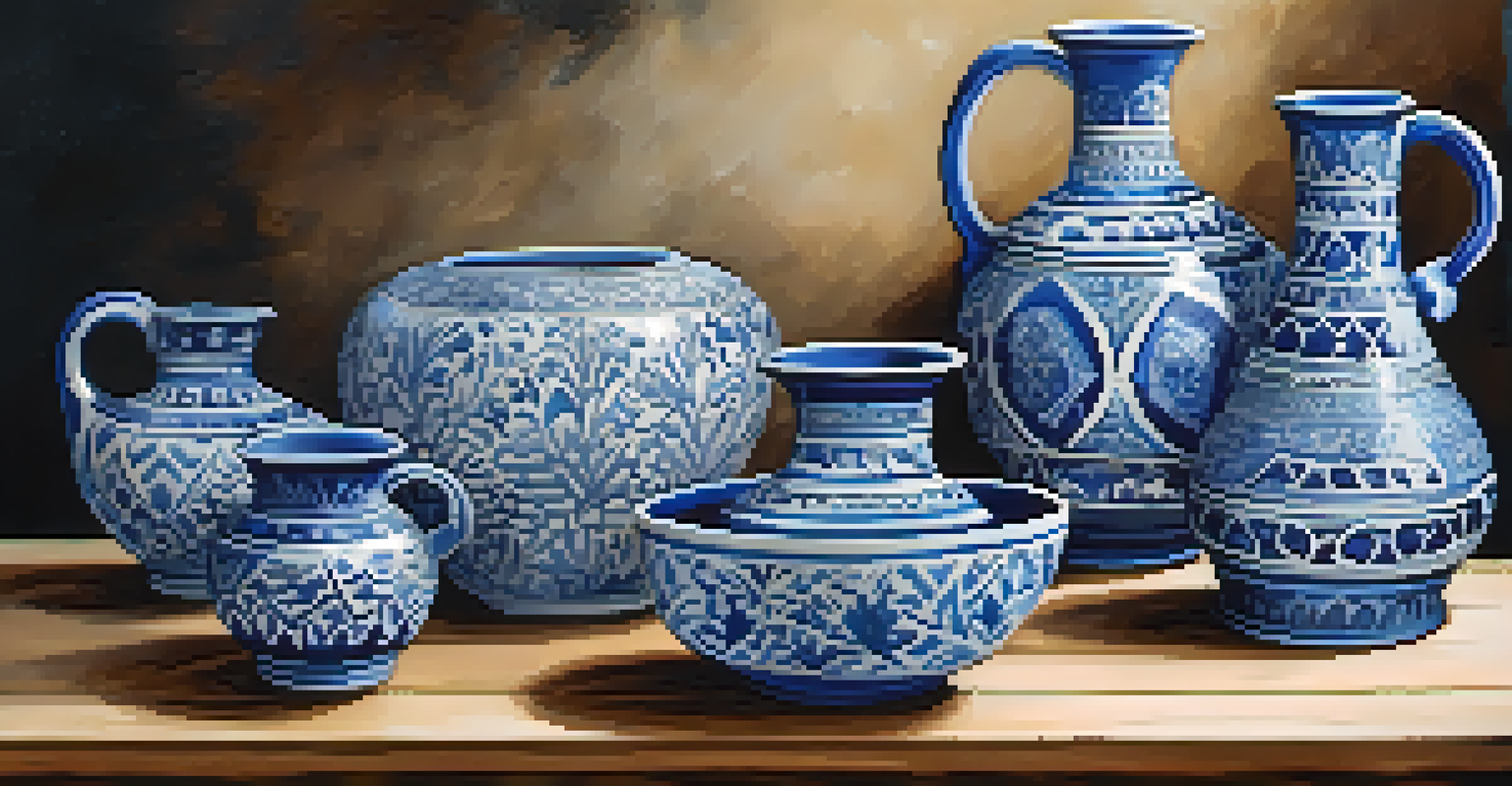Heritage Crafts of India: Preserving Tradition Through Artistry

The Rich Tapestry of Indian Heritage Crafts
India boasts a diverse range of heritage crafts that reflect its rich history and culture. From intricate textiles to elegant pottery, these crafts are more than just art; they tell stories of the people and regions from which they originate. Each craft is unique, often passed down through generations, making them invaluable treasures of cultural heritage.
Craft is an essential link to our cultural heritage and the stories that shape our identity.
For instance, the art of Bhutti weaving in Gujarat involves meticulous craftsmanship that has been honed over centuries. Similarly, the blue pottery of Jaipur showcases not only artistic skill but also the fusion of various cultural influences. Such crafts are a testament to the creativity and resourcefulness of artisans across the country.
By preserving these crafts, we also maintain important cultural narratives. They provide insights into our historical context and contribute to the national identity, reminding us of the rich legacies that shape our communities.
The Role of Artisans in Craft Preservation
Artisans are the backbone of India's heritage crafts, often dedicating their lives to mastering their skills. These craftsmen and craftswomen possess knowledge that is often not written down but is instead shared orally or through practice. This unique transmission of skills ensures that the art forms remain vibrant and alive.

Take, for example, the artisans involved in the creation of Pattachitra paintings from Odisha. Their expertise is not just in the technique but also in the storytelling that accompanies each piece. This deep connection to their craft fosters a sense of pride and responsibility to keep these traditions alive for future generations.
Heritage Crafts Reflect Cultural Identity
Indian heritage crafts embody rich histories and cultural narratives that are vital to the nation's identity.
However, the challenges they face in a rapidly modernizing world are significant. By supporting artisans through fair trade practices and creating platforms to showcase their work, we can help ensure that these traditions continue to thrive.
Challenges Facing Heritage Crafts in India
Despite their beauty and significance, many heritage crafts in India are at risk of fading away. Factors such as urbanization, globalization, and changing consumer preferences have made it difficult for traditional artisans to sustain their livelihoods. As mass-produced goods dominate the market, handmade crafts often struggle to compete.
Artisans are the keepers of our culture, preserving the traditions that define us.
For instance, the mukesh work of Kutch faces challenges as younger generations move to cities for better employment opportunities. This migration disrupts the passing down of traditional skills and knowledge, threatening the survival of these unique crafts. Without a concerted effort to support these artisans, we could lose an important part of our cultural heritage.
Additionally, the lack of financial resources and marketing support can hinder artisans from reaching wider audiences. Addressing these challenges requires collaboration between government, non-profit organizations, and consumers who value authenticity.
Reviving Heritage Crafts Through Education
Education plays a crucial role in reviving and preserving heritage crafts. By introducing programs that teach traditional crafts in schools and community centers, we can inspire a new generation to appreciate and engage with these art forms. Such initiatives not only help in skill development but also instill a sense of cultural pride.
Organizations like the National Institute of Fashion Technology (NIFT) have started incorporating traditional crafts into their curriculum, blending modern design with age-old techniques. This fusion not only preserves the craft but also encourages innovation, breathing new life into traditional practices.
Artisans Are Key to Craft Preservation
The skills and knowledge of artisans are crucial for keeping traditional crafts alive in a rapidly changing world.
Moreover, workshops and training programs led by experienced artisans can create a bridge between generations. These hands-on experiences can rekindle interest in these crafts and help young people see the value in pursuing traditional artistry.
The Impact of Government Policies on Crafts
Government policies play a vital role in the preservation and promotion of heritage crafts. Initiatives such as the 'Geographical Indication' (GI) tag help protect traditional crafts by recognizing their unique origins and ensuring that artisans receive recognition for their work. This not only uplifts artisans but also encourages tourism and appreciation of local crafts.
Furthermore, various schemes aimed at supporting small-scale artisans, like financial assistance and marketing support, can significantly impact their sustainability. By providing platforms for artisans to showcase their work, we can foster a thriving ecosystem that values traditional craftsmanship.
However, consistent implementation and awareness of these policies are crucial. Engaging with local communities and ensuring that artisans are informed about available resources can strengthen the craft sector and help preserve these invaluable traditions.
The Role of Technology in Craft Preservation
In today's digital age, technology offers exciting opportunities for preserving and promoting heritage crafts. Social media platforms and e-commerce websites provide artisans with the ability to reach a global audience. This increased visibility can help sustain their livelihoods and foster appreciation for their craft.
For instance, platforms like Instagram allow artisans to showcase their work and tell their stories, connecting with consumers who value handmade products. This not only helps in direct sales but also builds a community around shared values of sustainability and cultural preservation.
Support and Education Are Essential
Supporting artisans through fair trade and educational initiatives is vital for the revival and sustainability of heritage crafts.
Moreover, the use of technology in design and production processes can enhance traditional crafts without compromising their authenticity. By integrating modern tools while respecting traditional techniques, artisans can innovate and adapt to changing market demands while preserving their heritage.
Celebrating Heritage Crafts: A Collective Responsibility
Preserving heritage crafts is a collective responsibility that requires the involvement of consumers, artisans, and institutions. As consumers, we can make informed choices by supporting local artisans and choosing handmade products over mass-produced alternatives. This conscious decision not only helps sustain livelihoods but also fosters a deeper connection to cultural heritage.
Moreover, celebrating heritage crafts through festivals, exhibitions, and workshops can raise awareness and appreciation for these art forms. Events like the National Handloom Day encourage dialogue around the significance of traditional crafts and promote community engagement.

Ultimately, by valuing and integrating heritage crafts into our daily lives, we contribute to a richer cultural tapestry. Together, we can ensure that these timeless art forms continue to thrive for generations to come.